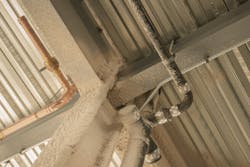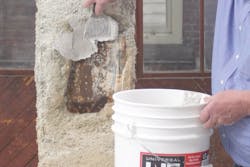Is Your Fireproofing Damaged? Why You Need to Maintain It
Spray applied fireproofing, or Sprayed Fire-Resistive Material (SFRM), protects rigid-structure elements in buildings against extreme heat generated during a fire. SFRM thermally insulates structural elements, such as beams, columns and metal decking, to keep them below critical temperatures during fire conditions.
If a structural element becomes exposed to excessive heat, it could lead to catastrophic failure. As a result, keeping the fireproofing maintained properly is a building occupant health and safety and liability issue that every facility manager should be aware of.
How Fireproofing Becomes Damaged
SFRM often gets knocked off after new construction, during building renovations, when new equipment is installed or even through careless daily activity. Electrical, plumbing, mechanical and cable contractors need to remove fireproofing when doing their work. Hanging pipe, conduit or cable often requires removing the fireproofing in order to fasten or weld hangers to the bare substrate, which greatly increases the chance of failure during a fire.
These breaches in fire protection must be repaired to maintain the fire rating.
[Related: Ways Your Fire Protection System Could Fail You]
Facility Managers’ Role in Fire Safety
Many buildings do not have specific personnel assigned to overseeing fire safety. The facility manager should have a baseline understanding of the fire protection system that is in place and how it affects the safety of occupants.
As part of this protocol, facility managers should help implement a plan that ensures that fireproofing is maintained effectively, including specifications for the right materials to use when patching SFRM.
Implications of Compromised Fireproofing
Heat from a fire will raise the temperature of steel from room temperature to approximately 1,500°F in a relatively short period. At approximately 1,100°F, the supporting steel loses about 65% of its strength. Failure can occur not when the whole beam or column reaches the higher temperature, but when just the portion of the structure left exposed does, which happens more quickly when there is no fireproofing.
There are no standards or codes that allow relaxing the integrity of fireproofing. Fire protection is a health and safety issue, and failing to properly maintain fire protections compliance can lead to significant liability and life safety issues.
Common Industry Patching Methods to Avoid
How to properly patch damaged fireproofing is a persistent issue. Many times, the wrong methods or materials are chosen. There is a lot to consider when making a patch, including application temperatures, material compatibility issues and applied thicknesses. The following methods should be avoided:
Applying Spray Material with a Trowel
Most patching options require using the same material as originally applied. Executing a trowel patch with a material that has been designed for spraying does not work well. The material slides instead of adhering. This is because most wet-application materials contain a slippage agent, an additive designed to allow the pumping of the wet material through a hose.
Using Broken Bags of SFRM
Builders often use broken bags of SFRM for patching. A broken or opened bag can become contaminated, leading to limited effectiveness, compatibility and verification.
Miscellaneous Building Materials
It is not uncommon for builders to pick up joint compound, sawdust and other construction scrap and apply these materials as a patch. This is one of the most dangerous methods, as a patch like this is almost guaranteed to fail. It is also not compliant, not to mention a danger to the lives of occupants.
Fireproofing patches are ideally made with a material specifically designed for patch jobs. The material should adhere to, and be compatible with, the range of common SFRMs. It should also perform with the right density, adhesion, cohesion and fire resistance.
Selecting a poor-quality or mismatched material can lead to challenging craftsmanship and a failed patch. Compromised fireproofing can lead to a failed structure.
About the Author:
Tim Vellrath is a professional engineer and the founder of Universal Fireproofing Patch (UFP). Before founding UFP, Tim was a fireproofing contractor and engineer for over 40 years. Contact Tim at [email protected].
Read next: Know Your Local Building and Fire Codes for Security Turnstiles and Doors
About the Author

Contributed Author
BUILDINGS partners with industry experts to bring you contributed content covering the hot topics for building owners and facility professionals.


